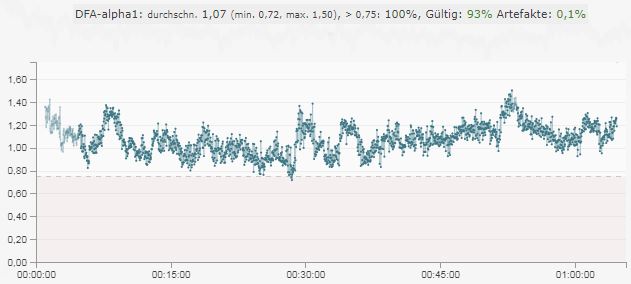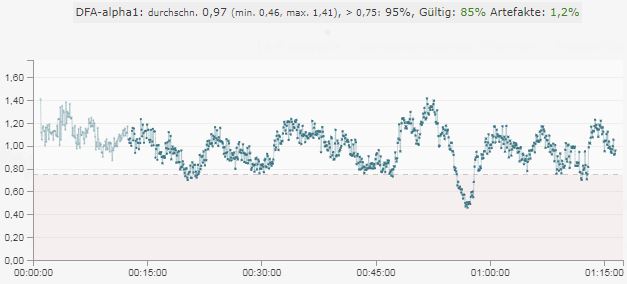That’s what my DFA Alpha 1 with the alphaHRV app (connected via ANT+) looks like…
no jumping over the place, but i think in general it’s a little bit too low, compared to the paralel recordings taken with BLE and evaluated with runalyze

That’s what my DFA Alpha 1 with the alphaHRV app (connected via ANT+) looks like…
no jumping over the place, but i think in general it’s a little bit too low, compared to the paralel recordings taken with BLE and evaluated with runalyze

I have added DFA a1 and EPOC to the activity timeline view. Note that these are fields taken from the fit file and not calculated by Intervals.icu. You need to do Actions → Reprocess File to get them for existing activities.
absolutly awesome! Thanks.
Is it also possible to set it on “Fields” so you can get an average of it for a given segment/selection?
Yes I have done that and also added W’bal start, end and delta. Will deploy Sat AM (GMT+2).
I have the same experience. a1 returned by the app is overall somewhat lower then what FatMaxxer is telling me. But not to the point that it would be unusable.
Your recording seems to have no artefacts at all. Mine has a few, and it was clear that the app had problems with them. A detected artefact on Fatmaxxer immediately showed as an unstable a1 on the app.
It is normal that there are some differences because the app uses another filtering method and measuring window.
App uses strong Kalman filter and window of 200 beats. That’s because the processing power of the head units is limited.
Fatmaxxer, Runalyze, Kubios and AI endurance use “smoothness priors” filtering and a 2 min window.
And that is why I would say that you can already safely use the app for real-time values but that it would be better to have a post-ride analysis with the techniques that are considered “standard”.
Its live:
Hello,
I understand that BT gives better signal quality right ? So you give a premium to post-ride analysis. Which app do you feed with the .fit file ? Kubios ? Thanks
That’s a consideration I made already a while ago. DFA-a1 calculation with Fatmaxxer code will come to Intervals, so I want the best possible RR data in my FIT file stored on Garmin and transferred to Intervals. I will have a load of dfa data already available in intervals for longer term analysis.
Right now, I use the csv Feature file from Fatmaxxer for post-ride analysis in Excel.
The IQ app will surely improve and almost certainly be good enough for real-time feedback but it will not be as accurate because of the processing limitations of the head units and watches now available.
using a wahoo Tickr HR Strap. (but connected to 2 different devices)
The ANT+ data looks way cleaner and all the SDSD/RMSSD is way off on the bluetooth. I wonder if it’s cos of artefacts, as I can see a number of points at 800ms and 600ms that’s definitely outliers.
Is the bluetooth data usable? valid?
I’ve thought Tickr was not among the recommended chest devices but Polar H9/H10 and 4iiii Viiiiva.
I’m happy you are getting good results with ANT+.
On the BT side I only have the Viiiiva but could never paired it with my Garmin Fenix 5x.
regards,
Yeah… it’s not, but that’s what I have currently that is still working. (I have 2x Tickr, 1 of them went into the washing machine for 1+hr and now is spotty connection)
I also have a 4iii Viiiiva, but somehow it’s also not working great. Connection drops.
The H10 has capability for 2x BLE connections. Would be good to get the HR to connect to both Garmin and BreakAway at the same time and compare the HRV data. But it’s really quite $
I guess it depends on the strap/device combo…
Polar H10 with Garmin units has been shown multiple times to have way less dropouts on BLE then ANT+
Regarding AlphaHRV app: the devs have confirmed that ANT+ is just as good as BLE. They have another way of getting the RR stream directly from the strap to the app and that’s why you need to pair it twice.
Developer Reply
February 9, 2022, InigoTE
It is usually advise to use BLE for HRV data recording on Garmin devices. BLE connection issues detected for some devices are been analysed now. Nevertheless alphaHRV is providing good and similar results for both ANT+ and BLE for the moment. At the end of the beta phase, some clear conclusions will be provided on this.
Hello, I gave a shot to the CIQ app this morning. I paired the app with BT and Fenix 6 with Ant+
To me, it’s mixed results… I have played a lot with my lactate pro 2 lately and I think I have a fairly good definition of the wattage for my zone 2. I know from various recent workouts that my aerobic threshold, where lactate usually rise above 2 is somewhere around 3,8 W/kg
So this morning I did a clamped effort around 3,7-3,8 W/kg, I had some HR drift so maybe I am not really in endurance but my lactate was 1,4 mmol/l at the end.
DFA1a for 155ish HR which I believe is a good proxy for my aerobic threshold (VT1) varied a lot… at the end of my 1h clamped effort, DFA1a even dropped below 0,5 but lactate was 1,4…
To fill in the gaps: there’s a phone app in the making for dfa-a1 on iPhone too
Not quite sure what to say here but for an FTP of 250W the 229W target is rather high to consider this endurance zone. VT1 is usualy somewhere in between 70-80% FTP.
On the other hand, there are people who have big differences between VT1 and LT1. Could be your case.
Thank you for your answer. I have worked a lot around LT1 so maybe I hope I have pushed it.
Today, I have done another clamped effort at 200W. HR was quite stable. DFA1a wasn’t.
Maybe it’s an interesting signal, maybe keeping it around 0,8 is a good marker for mere endurance. But these 2 tests show the limit of this technique for me…
The reason for pairing it twice is because I’m pretty sure (I didnt check the SDK API) you can’t get HRV data from the strap thru Garmin’s SDK API for Connect IQ). When the app connect directly to the strap, you can get whatever the strap is transmitting w/o going thru the SDK.
Yeah… That’s what I read tho i have no way to test since I don’t have a H10 and my Tickr has only 1 BTLE channel so can’t compare… Although now that you mentioned the diff pairing method for the CIQ app, it might be workable to upload the same workout data to RunAnalyze (Garmin - BLE HRV and Garmin-CIQ App - ANT+ HRV). Something to think about for me.
anyhow, I stumbled upon this nugget of info. I found out that GoldenCheetah now also is able to process DFAa1 data. (not sure about live view) but it’s available for Post-Analysis…
No clue(at all) what all this means, but this is the same workout I put into RunAnalyze (I shared in an earlier post)
ANT+ HRV Data
BLE HRV Data
So… RunAnalyze shows that the HRV data is cleaner on ANT+ but the DFAa1 plot seems like the opposite.
The BLE on the other hand, RunAnalyze shows a larger variation but is a lot cleaner on the DFAa1 plot.
Care to share your thoughts?
Or should I be doing some “test” workout to get the proper data?
Like this workout from here:
Today I found out how exactly @Andreas_Fitz was getting the DFA-A1 plot from RunAnalyze. (Didnt know about it until I dig)
Bluetooth
It’s interesting to see that ANT+ while having a cleaner visual, graph wise, actually has only ~5% valid Points (which I presume based on the data being shown, any window size of 120s > 3% artifact is invalid)
TBH - I still have no idea what to make of this data
… just for interest …
yesterday i did a ride and my average DFA Alpha1 from Runalyze (Garmin + BLE) was 0,97.

from the new alphaHRV app (via ANT+) my average was 0,89… so 8-9% difference
I also had one heart extracystole at the end of the ride, and here the DFA Alpha 1 from alphaHRV app drops immediately from 1.0 to 0.4… so the “artefact” isn’t corrected.
This doesn’t happen in runalyze (Garmin + BLE), it’s corrected here.
How did you get the DFAAlpha1 chart to show in Runalyze, and is it Runalyze analysis of Garmin HRV data or just the data field data from IQ Connect?